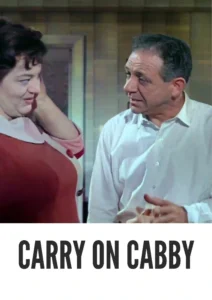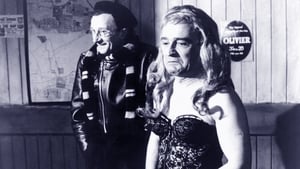Contact: info@alwanfilm.com
Video Sources 0 Views

Carry On Cabby 1963 Colorized
Synopsis
Review: Carry On Cabby 1963 Colorized – A Classic British Comedy on the Move

Introduction
In the vast and often chaotic world of British comedy, few film series hold as iconic a place as the Carry On franchise. Among the 31 films in the series, Carry On Cabby (1963) stands out as a delightful blend of slapstick humor, social commentary, and charming performances. Directed by Gerald Thomas, this installment revolves around the world of London taxi drivers, their competitive spirits, and the quintessential British humor that defined the era. In this article, we will explore the significance of Carry On Cabby, discuss its cast, the story, and the humor that makes it a beloved gem in British cinema.
Check The Full Colorized Movies List
Check Our Colorized Movies Trailer Channel
Understanding Carry On Cabby 1963 Colorized: Director, Cast, and Genre
Carry On Cabby is directed by Gerald Thomas, who helmed nearly all the films in the Carry On series, making him synonymous with the franchise’s unmistakable style. His collaboration with producer Peter Rogers and the consistent use of recurring actors allowed the films to develop a signature comedic tone. Carry On Cabby exemplifies this blend of farce, double entendre, and cheeky British humor, while also touching upon issues of gender roles and marital dynamics, themes that still resonate today.
The film features a stellar cast of Carry On regulars, including Sid James, Hattie Jacques, Kenneth Connor, and Charles Hawtrey. Sid James, with his gravelly voice and mischievous charm, plays Charlie Hawkins, the hard-working, stubborn cab company owner. Hattie Jacques portrays Peggy, Charlie’s long-suffering wife, who becomes the unexpected catalyst for the central conflict. Jacques’ performance as the assertive and resourceful Peggy adds depth to the film, as it subtly addresses the changing roles of women in the 1960s.
Kenneth Connor provides his usual comedic flair as Ted Watson, Charlie’s loyal but bumbling right-hand man. Charles Hawtrey, known for his effeminate and quirky persona, plays a minor but memorable role as the eccentric cab driver “Pintpot.”
In terms of genre, Carry On Cabby falls squarely into the category of British comedy, specifically the farce subgenre. It blends physical comedy with witty dialogue, and while it leans heavily on humor, it also incorporates light social commentary, particularly around the dynamics between men and women in the workplace and at home.
Exploring the World of Carry On Cabby 1963 Colorized: Plot and Characters
The story of Carry On Cabby is centered on Charlie Hawkins (Sid James), a workaholic owner of a taxi cab company, Speedee Cabs, who prioritizes his business over everything else—including his marriage. Charlie’s single-minded focus on running his company has strained his relationship with his wife, Peggy (Hattie Jacques), who feels neglected and unappreciated. Frustrated by Charlie’s obsession with his work, Peggy hatches a plan to teach him a lesson by starting her own rival cab service.
Unbeknownst to Charlie, Peggy secretly launches GlamCabs, an all-female taxi service that quickly becomes a sensation. The glamorous and attractive women drivers, all clad in smart uniforms, attract male customers in droves, putting Speedee Cabs under severe pressure. As Charlie’s business begins to suffer, he remains oblivious to the fact that his wife is behind the competition. His attempts to sabotage GlamCabs only lead to further comedic mishaps, culminating in a final showdown between the two cab companies.
The film is driven by the rivalry between Charlie and Peggy, as well as the comedic ensemble of supporting characters, including Kenneth Connor’s hapless Ted, who is unwittingly caught up in the chaos, and Charles Hawtrey’s Pintpot, who provides comic relief with his usual eccentricity. The humor in Carry On Cabby comes from the misunderstandings, slapstick moments, and the battle of wits between the two leads, making it a classic example of British farce.
The Art of British Farce in Carry On Cabby 1963 Colorized
The Carry On series is famous for its use of farce, a comedic style that relies on exaggerated situations, physical comedy, and mistaken identities. In Carry On Cabby, this style is evident in the many humorous misunderstandings between Charlie and Peggy, as well as the outrageous lengths to which Charlie goes to thwart his new competitors.
Farce works particularly well in Carry On Cabby because it taps into the everyday world of working-class Londoners while heightening the absurdity of their situations. The rivalry between two cab companies might seem like a mundane plotline, but the film elevates it into a humorous battleground of genders, with Peggy and her team of female drivers representing a modern, liberated spirit that contrasts with Charlie’s traditional, male-dominated world.
Gender Roles and Social Commentary in Carry On Cabby 1963 Colorized
One of the most interesting aspects of Carry On Cabby is its commentary on gender roles, especially given the context of the early 1960s. At the heart of the film is the tension between Charlie’s old-fashioned views on marriage and work and Peggy’s desire for independence and recognition. Although the film remains primarily a comedy, Peggy’s character reflects the growing awareness of women’s rights and changing societal roles in Britain during the 1960s.
Peggy’s decision to start her own cab company is not only a response to her personal frustrations with Charlie but also a representation of the broader push for gender equality. The success of GlamCabs, run by capable and glamorous women, serves as a subtle (and humorous) challenge to the male-dominated taxi business. While Carry On Cabby doesn’t delve deeply into feminist ideology, it does highlight the growing empowerment of women, even if framed through the lens of comedy.
The Legacy of Carry On Cabby and the Carry On Series
As part of the Carry On series, Carry On Cabby contributed to the enduring popularity of these films throughout the 1960s and beyond. The series, known for its ability to poke fun at British institutions and social conventions, became a cornerstone of British popular culture. Although often dismissed by critics as light entertainment, the Carry On films remain beloved by audiences for their charm, wit, and irreverence.
Carry On Cabby holds a special place in the series because it introduces real-world tension between its lead characters, creating a storyline that resonates with themes of work-life balance and marital strife—issues that remain relevant to this day. Additionally, Sid James and Hattie Jacques’ chemistry elevates the film, adding warmth and depth to their comedic performances.
The success of Carry On Cabby also paved the way for more Carry On films centered around everyday professions and institutions. Films like Carry On Doctor (1967) and Carry On Camping (1969) would further explore similar themes of authority, social norms, and the clashes between genders.
Reception and Critical Response to Carry On Cabby 1963 Colorized
Upon its release in 1963, Carry On Cabby was met with positive reactions from audiences, particularly fans of the Carry On series. The film’s blend of physical comedy, clever dialogue, and endearing characters made it a hit with cinema-goers. However, as with many of the Carry On films, it was often viewed by critics as frivolous entertainment, lacking the sophistication of other British comedies from the era.
Despite this, Carry On Cabby has endured as a beloved entry in the franchise, thanks to its sharp humor, memorable performances, and the chemistry between its leads. Over the years, it has become a cult favorite, appreciated for its charm and the light-hearted way it deals with themes of gender and power dynamics.
Where to Watch Carry On Cabby 1963 Colorized Online
For modern viewers, Carry On Cabby is readily available on various streaming platforms and home video formats. Many of the Carry On films, including Carry On Cabby, can be found on platforms such as Amazon Prime Video, BritBox, and YouTube, either for purchase or rental. These services offer an opportunity for new audiences to discover—or rediscover—this classic British comedy.
Additionally, the film is often included in box sets and collections of the Carry On series, making it easy for fans to enjoy the entire franchise. Whether you’re a longtime fan or a newcomer to the series, Carry On Cabby is a must-watch for anyone who appreciates British humor and timeless comedy.
FAQs About Carry On Cabby 1963 Colorized
Q: What is the main theme of Carry On Cabby?
A: The main theme of Carry On Cabby revolves around work-life balance and gender dynamics, with the central conflict being the rivalry between a husband’s taxi company and his wife’s all-female cab service.
Q: Is Carry On Cabby a family-friendly film?
A: Yes, like most films in the Carry On series, Carry On Cabby is suitable for family viewing. While it contains mild innuendo and slapstick humor, it is generally light-hearted and inoffensive.
Q: Does Carry On Cabby have a happy ending?
A: Without giving too much away, Carry On Cabby resolves its central conflict in a humorous and heartwarming manner, typical of the Carry On series.
Conclusion
Carry On Cabby (1963) is a delightful example of British comedy at its finest, blending farcical humor with gentle social commentary. While the film is primarily a lighthearted romp, it also touches on issues of gender roles, marital dynamics, and work-life balance, making it relevant even today. With standout performances by Sid James and Hattie Jacques, and the unmistakable charm of the Carry On ensemble, Carry On Cabby remains a beloved classic in the pantheon of British cinema. Whether you’re a fan of the Carry On series or a newcomer to its unique brand of humor, this film offers a timeless and entertaining ride.














